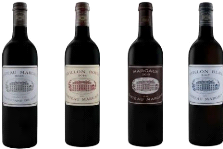3.3 The wines produced by Château Margaux in a
context of climate change
3.3.1 Presentation of the wines of Château
Margaux
The property produces 4 wines:
- The first red wine, called «Grand Vin du Château
Margaux»
- The second red wine, called «Pavillon rouge du
Château Margaux»
- The third red wine, called «Margaux du Château
Margaux»
- A white wine, called «Pavillon Blanc du Château
Margaux»
The red wines are produced under the Margaux PDO, while the
white one is produced under the Bordeaux PDO. The wine that isn't selected for
those four bottles is intended to produce two generic wines (one red and one
white), sold in bulk.

Figure 4: Wines produced and sold by Château
Margaux (Château Margaux, 2022)
270 000 bottles of red wine, and 10 000 bottles of white wine
are produced each year. The most produced red wine is their first classified
red wine, with 130 000 bottles produced each year.
The first wine of Château Margaux is known for its
quality and typicity. Sensorially speaking, the wine is recognizable for its
silky tannins, gustatory sweetness, elegance, floral aromas, etc. Those
specific features are produced in a certain terroir and climate and cannot be
reproduced in different conditions. Undoubtedly, climate change will affect
those features, affecting the wine typicity.
3.3.2 The typicity of the wines of Château
Margaux
The wines produced by Château Margaux are known all over
the world for their exceptional taste and quality. In order to understand the
effects of global warming on Château Margaux's products, the key factors
that condition the quality of their wines need to be defined first.
According to the vineyard manager (interview in Annex
2), the typicity of Château Margaux's wines comes from their terroir.
With more than 60 different types of soil units and 3 types of terrasses,
Château
20
Margaux has the potential to produce a more complex blend than
its neighbors, enriching the wines' profiles. The soil map of the parcels can
be found in Annex 3.
Grape quality is a result of every action in the vineyard. At
Château Margaux, all of the tasks are handmade for a higher precision.
Every vineyard worker takes care of specific parcels so that they become
responsible and precautious of their work.
Pedological studies are done frequently in parcels to identify
their terroir specificities and decide in which type of wine the parcel will
go. Also, the company keeps records of the parcels' history specifying which
type of wine each of them has produced throughout the years. Thanks to that
information, and based on the type of vintage, decisions are taken each year
regarding the blend.
The vinification process also interferes with wine quality, as
the operations are directed to optimize the berry quality through analytical
data and tastings.
3.3.3 The impact of climate change on the wines of
Château Margaux
Climate change will directly impact the wines of Château
Margaux. According to the vineyard manager (interview in Annex 2),
climate change will impact the quality of the produced wines, as the berries
will taste differently due to higher sun exposure.
Climate change might also cause differences in berry taste due
to other factors such as drought or even intense rainfall. Château
Margaux being renowned in the wine industry for its wine quality and typicity,
implementing new practices to reduce the effects of climate change on their
vineyard might change the wines profiles and therefore impact the company's
popularity.
| 


